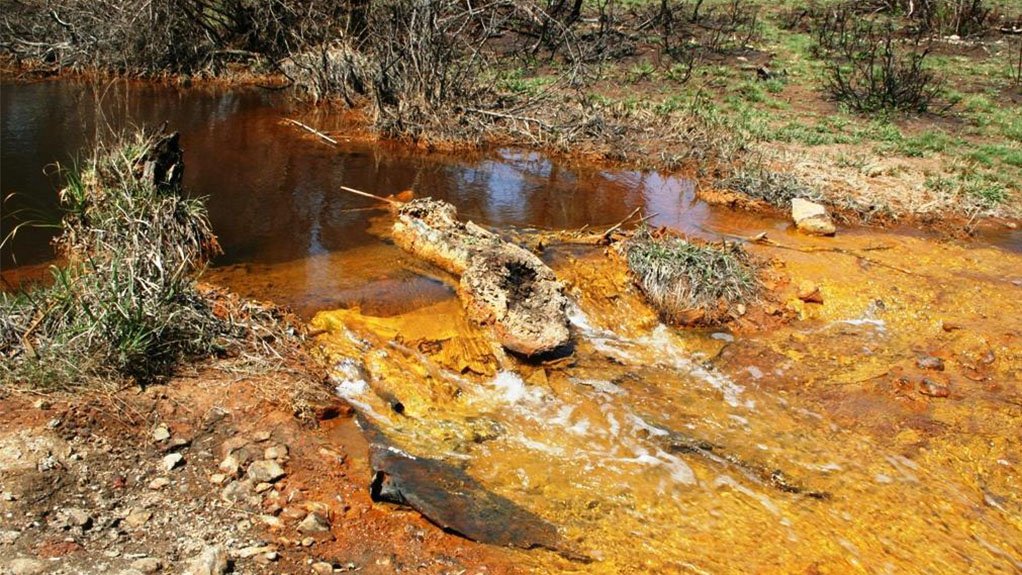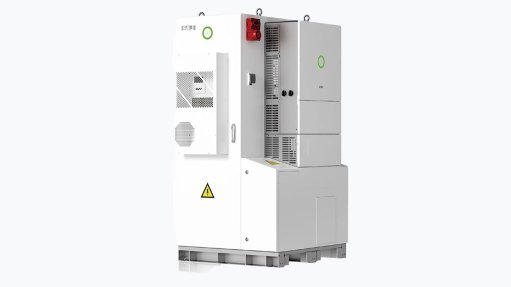AMD treatment could start transitioning from expensive, energy-intensive treatments to natural attenuation
The quality of mine water discharge has improved significantly over the last decade, and research suggests that government could consider a transition away from current, active acid mine drainage (AMD) treatments, to a more passive approach.
Council for Geoscience (CGS) environmental geosciences senior scientist Dr Godfrey Madzivire, speaking at the 2022 CGS Summit, explained that AMD is currently treated using High-Density Sludge (HDS) treatment plants, which are costly and energy intensive.
Moreover, as the HDS plants are powered by coal-fired power stations, the current solution is, in essence, “shifting the burden from the hydrosphere to the atmosphere”.
In his presentation on ‘Natural processes in pollution attenuation: case study for a long-term solution to mine water management in the Witwatersrand goldfields', he explained that AMD is characterised by two types of acidity – vestigial acidity and juvenile acidity.
In an earlier presentation, CGS water and the environment specialist scientist Dr Henk Coetzee explained that vestigial acidity is generated by the initial flushing of solid oxidation products, that is, the soluble salts formed when pyrite is oxidised, which are “flushed out” as the water level rises.
Vestigial acidity has high salinity and is of very poor quality, but is short-lived. Juvenile acidity, meanwhile, is the newly generated acidity, which is less contaminated and its rate of generation slows substantially after initial flooding.
Madzivire explained that vestigial acidity is depleted after 20 to 40 years, while juvenile acidity continues “in perpetuity”.
He stated that current AMD treatment methods resulted from the Inter-Ministerial Recommendations Committee Report, published in 2010, which used a model developed by the Department of Water and Sanitation, which “did not consider natural attenuation”.
He commented that, when mining activity ceases and the water is allowed to rise – as the pumps that maintain the water level are shut off – the highly toxic “first flush” occurs, with the quality of the mine water discharge improving thereafter.
He noted that the inter-Ministerial recommendations were based on results compiled between 2002 and 2010, during the first flush stage for a significant number of mines, and as a result the water had very high sulphate concentrations and pH values as low as 2. However, as early as 2010, the mine water pH had improved to between 5.5. and 6, and over the last decade, sulphate concentration in the mine discharge has declined by 30%, while iron concentration has declined by 50%.
Given these improvements, Madzivire suggested that a shift toward more sustainable water management solutions in the Wits basin should be pursued, outlining scenarios for long-term mine water management such as completely flooding the mine void; using water to dilute vestigial pollution or passive treatment also known as natural attenuation.
He cited preliminary results from the East Rand AMD treatment facilities, noting that when water is discharged from the mines, it has a sulphate concentration of 1 500 mg/l. “Just after, when it mixes with the water in the Blesbok, the concentration declines to 300 mg/l. We still need to explore if this is because of the dilution, or natural attenuation. As the water flows towards the Vaal River system, additional natural processes occur, and the sulphate concentration drops further to 200 mg/l, which is better than the recommended rate for potable water.”
He commented that it is uncertain if entities can continually use HDS to treat the water in the mine void, and while the ideal solution is dilution, the dilution source can also be highly polluted, and the likelihood of experiencing “ideal” conditions is slim. As such, passive methods, in conjunction with controlled flooding, are the most feasible for longer-term mine water management.
CONTROLLED FLOODING
Coetzee, in his presentation on ‘Flooding of the Witwatersrand gold mines: the influence of topography on long-term water quality', noted that acid generation was negligible in the thousands of years before the Witwatersrand rock was exposed by mining activity.
He explained that the mine environment below the water level is generally anaerobic; consequently, pyrite oxidisation is unlikely to occur. However, above the water level, sulphate oxidation and juvenile acidity would persist.
He commented that during the 2000s, the pyrite was largely inundated and, as a result, new oxidation became limited to the relatively narrow upper portion of the workings.
Therefore, he suggested that the old mine workings be flooded in a controlled manner, resulting in a band of about 200 m above the water level, but roughly 3 000 m below it. He noted that the water level would be maintained by surface discharge and that the elevated topography in parts of the Witwatersrand would prevent complete flooding.
The inference is that, while water ingress in the unflooded area would result in juvenile acidity, it could be managed, relatively easily, through dilution and passive treatments.
Article Enquiry
Email Article
Save Article
Feedback
To advertise email advertising@creamermedia.co.za or click here
Comments
Press Office
Announcements
What's On
Subscribe to improve your user experience...
Option 1 (equivalent of R125 a month):
Receive a weekly copy of Creamer Media's Engineering News & Mining Weekly magazine
(print copy for those in South Africa and e-magazine for those outside of South Africa)
Receive daily email newsletters
Access to full search results
Access archive of magazine back copies
Access to Projects in Progress
Access to ONE Research Report of your choice in PDF format
Option 2 (equivalent of R375 a month):
All benefits from Option 1
PLUS
Access to Creamer Media's Research Channel Africa for ALL Research Reports, in PDF format, on various industrial and mining sectors
including Electricity; Water; Energy Transition; Hydrogen; Roads, Rail and Ports; Coal; Gold; Platinum; Battery Metals; etc.
Already a subscriber?
Forgotten your password?
Receive weekly copy of Creamer Media's Engineering News & Mining Weekly magazine (print copy for those in South Africa and e-magazine for those outside of South Africa)
➕
Recieve daily email newsletters
➕
Access to full search results
➕
Access archive of magazine back copies
➕
Access to Projects in Progress
➕
Access to ONE Research Report of your choice in PDF format
RESEARCH CHANNEL AFRICA
R4500 (equivalent of R375 a month)
SUBSCRIBEAll benefits from Option 1
➕
Access to Creamer Media's Research Channel Africa for ALL Research Reports on various industrial and mining sectors, in PDF format, including on:
Electricity
➕
Water
➕
Energy Transition
➕
Hydrogen
➕
Roads, Rail and Ports
➕
Coal
➕
Gold
➕
Platinum
➕
Battery Metals
➕
etc.
Receive all benefits from Option 1 or Option 2 delivered to numerous people at your company
➕
Multiple User names and Passwords for simultaneous log-ins
➕
Intranet integration access to all in your organisation

















